 W
WGlyptodonts are an extinct clade of large, heavily armoured armadillos. They arose in South America around 20 million years ago and spread to southern North America after the continents became connected several million years ago. The best-known genus within the group is Glyptodon.
 W
WMegatheriidae is a family of extinct ground sloths that lived from approximately 23 mya—11,000 years ago.
 W
WMylodontidae is a family of extinct South American and North American ground sloths within the suborder Folivora of order Pilosa, living from around 23 million years ago (Mya) to 11,000 years ago. This family is most closely related to another family of extinct ground sloths, Scelidotheriidae, as well as to the extant arboreal two-toed sloths, family Choloepodidae; together these make up the superfamily Mylodontoidea. Phylogenetic analyses based on morphology uncovered the relationship between Mylodontidae and Scelidotheriidae; in fact, the latter was for a time considered a subfamily of mylodontids. However, molecular sequence comparisons were needed for the correct placement of Choloepodidae. These studies have been carried out using mitochondrial DNA sequences as well as with collagen amino acid sequences. The latter results indicate that Choloepodidae is closer to Mylodontidae than Scelidotheriidae is. The only other living sloth family, Bradypodidae, belongs to a different sloth radiation, Megatherioidea.
 W
WNothrotheriidae is a family of extinct ground sloths that lived from approximately 11.6 mya—11,000 years ago, existing for approximately 11.49 million years. Previously placed within the tribe Nothrotheriini or subfamily Nothrotheriinae within Megatheriidae, they are now usually placed in their own family, Nothrotheriidae. Nothrotheriids appeared in the Tortonian, some 11.6 million years ago, in South America. The group includes the comparatively slightly built Nothrotheriops, which reached a length of about 2.75 metres (9.0 ft). While nothrotheriids were small compared to some of their megatheriid relatives, their claws provided an effective defense against predators, like those of larger anteaters today.
 W
WPampatheriidae is an extinct family of large plantigrade armored xenarthrans related to armadillos. However, pampatheriids have existed as a separate lineage since at least the middle Eocene Mustersan age, 45 to 48 million years ago. Pampatheres evolved in South America during its long period of Cenozoic isolation. Although widespread, they were less diverse and abundant than the armadillos. Holmesina spread to North America after the formation of the Isthmus of Panama as part of the Great American Interchange. They finally disappeared on both continents in the end-Pleistocene extinctions, about 12,000 years ago.
 W
WDasypus bellus, the beautiful armadillo, is an extinct armadillo species endemic to North America and South America from the Pleistocene, living from 1.8 mya—11,000 years ago, existing for approximately 1.789 million years.
 W
WEleutherocercus was a genus of glyptodonts that lived during the Late Miocene and Early Pliocene in South America. Fossils of the genus have been found in the Huayquerian Ituzaingó Formation and the Montehermosan Monte Hermoso Formation in Argentina.
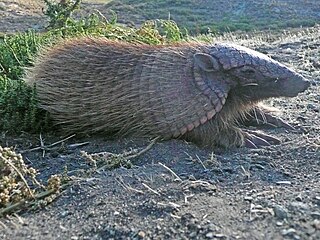 W
WEuphractinae is an armadillo subfamily in the family Chlamyphoridae.
 W
WGlossotherium was a genus of ground sloth. It was a heavily built animal with a length of about 4 metres (13 ft) snout to tail-tip, a weight estimated at 1,000 kg (2,200 lb), and could potentially assume a slight bipedal stance.
 W
WGround sloths are a diverse group of extinct sloths, in the mammalian superorder Xenarthra. The term is used as a reference for all extinct sloths because of the large size of the earliest forms discovered, as opposed to existing tree sloths. The Caribbean ground sloths, the most recent survivors, lived in the Antilles, possibly until 1550 BCE. However, radiocarbon dating suggests an age of between 2819 and 2660 BCE for the last occurrence of Megalocnus in Cuba. Ground sloths had been extinct on the mainland of North and South America for 10,000 years or more. They survived 5,000–6,000 years longer in the Caribbean than on the American mainland, which correlates with the later colonization of this area by humans.
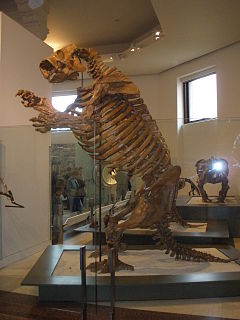 W
WLestodon is an extinct genus of megafaunal ground sloth from South America during the Pliocene to Pleistocene periods. Its fossil remains have been found in Argentina, Paraguay, Uruguay, Venezuela, Bolivia, and Brazil. Measuring approximately 4.6 metres (15 ft) from snout to tail tip, it is estimated to have weighed 2,590 kilograms. It was a herbivore and primarily fed on the grasses on the South American plains and is thought to perhaps have used its semi-bipedal stance to obtain foliage from trees. Lestodon is placed as member of the Mylodontidae as indicated by the lobed form of the last tooth in the dentition.
 W
WMacroeuphractus is a genus of extinct armadillos from the Late Miocene to Late Pliocene of South America. The genus is noted for its large size, with Macroeuphractus outesi being the largest non-pampathere or glyptodont armadillo discovered, as well as its specializations for carnivory, unique among all xenarthrans.
 W
WMegalonyx is an extinct genus of ground sloths of the family Megalonychidae, native to North America during the Pliocene and Pleistocene epochs. It became extinct during the Quaternary extinction event at the end of the Rancholabrean of the Pleistocene, living from ~5 million to 11,000 years ago. The type species, M. jeffersonii, measured about 3 meters (9.8 ft) and weighed up to 1,000 kilograms (2,200 lb). Megalonyx is descended from Pliometanastes, a genus of ground sloth that had arrived in North America during the Late Miocene, prior to the Great American Biotic Interchange. Megalonyx had the widest distribution of any North American ground sloth, having a range encompassing most of the contiguous United States, extending as far north as Alaska during warm periods.
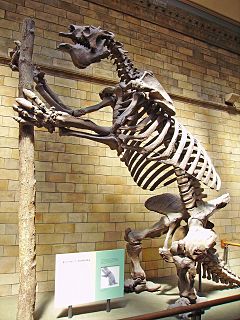 W
WMegatherium is an extinct genus of ground sloths endemic to South America that lived from the Early Pliocene through the end of the Pleistocene. It is best known for the elephant-sized type species M. americanum, sometimes called the giant ground sloth, or the megathere, native to the Pampas through southern Bolivia during the Pleistocene. Various other smaller species belonging to the subgenus Pseudomegatherium are known from the Andes. Megatherium is part of the sloth family Megatheriidae, which also includes the similarly elephantine Eremotherium, which was native to tropical South America and southern North America. Only a few other land mammals equaled or exceeded M. americanum in size, such as large proboscideans and the giant rhinoceros Paraceratherium. Megatherium was first discovered in 1788 on the bank of the Luján River in Argentina. The holotype specimen was then shipped to Spain the following year wherein it caught the attention of the paleontologist Georges Cuvier, who was the first to determine, by means of comparative anatomy, that Megatherium was a sloth. Megatherium became extinct around 12,000 years ago during the Quaternary extinction event, which also claimed most other large mammals in the New World. The extinction coincides with the settlement of the Americas, and a kill site where a M. americanum was slaughtered and butchered is known, suggesting that hunting could have caused its extinction.
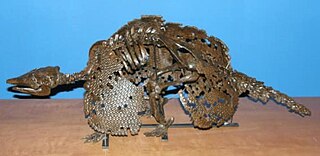 W
WPachyarmatherium is a genus of extinct large armadillo-like cingulates found in North and South America from the Pliocene and Pleistocene epochs, related to the extant armadillos and the extinct pampatheres and glyptodonts. It was present from 4.9 Mya to 11,000 years ago, existing for approximately 4.889 million years.
 W
WScelidotheriidae is a family of extinct ground sloths within the order Pilosa, suborder Folivora and superfamily Mylodontoidea, related to the other extinct mylodontoid family, Mylodontidae, as well as to the living two-toed sloth family Choloepodidae. The only other extant family of the suborder Folivora is the distantly related Bradypodidae. Erected as the family Scelidotheriidae by Ameghino in 1889, the taxon was demoted to a subfamily by Gaudin in 1995. However, recent collagen sequence data indicates the group is less closely related to Mylodon and Lestodon than Choloepus is, and thus it has been elevated back to full family status by Presslee et al. (2019).
 W
WThalassocnus is an extinct genus of semiaquatic ground sloths from the Miocene and Pliocene of the Pacific South American coast. It is monotypic within the subfamily Thalassocninae. The five species—T. antiquus, T. natans, T. littoralis, T. carolomartini, and T. yuacensis—represent a chronospecies, a population gradually adapting to marine life in one direct lineage. They are the only known aquatic sloths. They have been found in the Pisco Formation of Peru and the Bahía Inglesa, Coquimbo, and Horcón formations of Chile. Thalassocninae has been placed in both the families Megatheriidae and Nothrotheriidae.
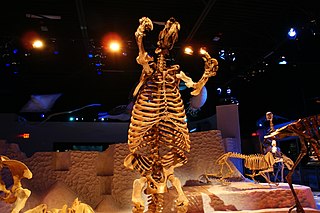 W
WThinobadistes is an extinct genus of ground sloth of the family Mylodontidae endemic to North America during the Miocene-Pliocene epochs (Hemphillian). It lived from 10.3—4.9 mya, existing for approximately 5.4 million years.